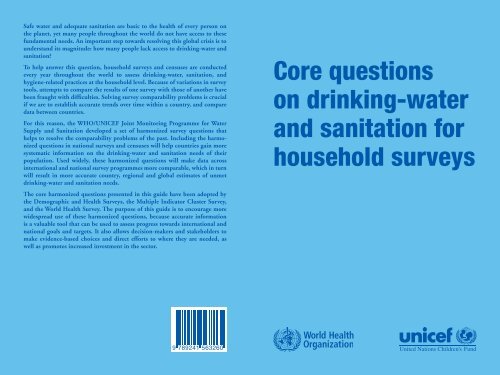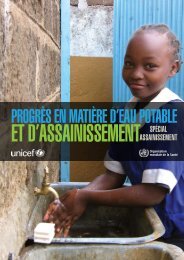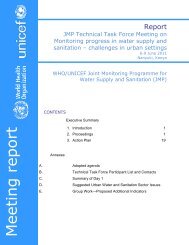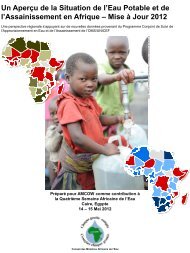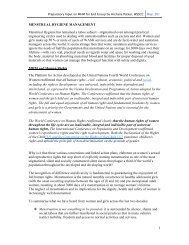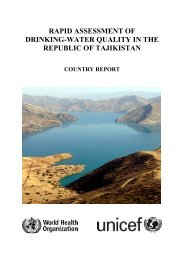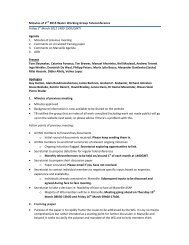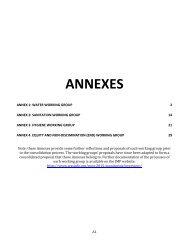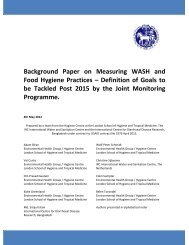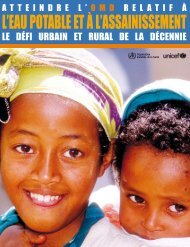download PDF - WHO/UNICEF Joint Monitoring Programme
download PDF - WHO/UNICEF Joint Monitoring Programme
download PDF - WHO/UNICEF Joint Monitoring Programme
Create successful ePaper yourself
Turn your PDF publications into a flip-book with our unique Google optimized e-Paper software.
Safe water and adequate sanitation are basic to the health of every person on<br />
the planet, yet many people throughout the world do not have access to these<br />
fundamental needs. An important step towards resolving this global crisis is to<br />
understand its magnitude: how many people lack access to drinking-water and<br />
sanitation?<br />
To help answer this question, household surveys and censuses are conducted<br />
every year throughout the world to assess drinking-water, sanitation, and<br />
hygiene-related practices at the household level. Because of variations in survey<br />
tools, attempts to compare the results of one survey with those of another have<br />
been fraught with difficulties. Solving survey comparability problems is crucial<br />
if we are to establish accurate trends over time within a country, and compare<br />
data between countries.<br />
For this reason, the <strong>WHO</strong>/<strong>UNICEF</strong> <strong>Joint</strong> <strong>Monitoring</strong> <strong>Programme</strong> for Water<br />
Supply and Sanitation developed a set of harmonized survey questions that<br />
helps to resolve the comparability problems of the past. Including the harmonized<br />
questions in national surveys and censuses will help countries gain more<br />
systematic information on the drinking-water and sanitation needs of their<br />
population. Used widely, these harmonized questions will make data across<br />
international and national survey programmes more comparable, which in turn<br />
will result in more accurate country, regional and global estimates of unmet<br />
drinking-water and sanitation needs.<br />
The core harmonized questions presented in this guide have been adopted by<br />
the Demographic and Health Surveys, the Multiple Indicator Cluster Survey,<br />
and the World Health Survey. The purpose of this guide is to encourage more<br />
widespread use of these harmonized questions, because accurate information<br />
is a valuable tool that can be used to assess progress towards international and<br />
national goals and targets. It also allows decision-makers and stakeholders to<br />
make evidence-based choices and direct efforts to where they are needed, as<br />
well as promotes increased investment in the sector.<br />
Core questions<br />
on drinking-water<br />
and sanitation for<br />
household surveys
CORE QUESTIONS<br />
ON DRINKING-WATER<br />
AND SANITATION FOR<br />
HOUSEHOLD SURVEYS
<strong>WHO</strong> Library Cataloguing-in-Publication Data<br />
Core questions on drinking-water and sanitation for household surveys.<br />
1.Water supply. 2.Sanitation. 3.Data collection - standards. 4.Guidelines. I.<strong>WHO</strong>/<strong>UNICEF</strong> <strong>Joint</strong> <strong>Monitoring</strong> <strong>Programme</strong><br />
for Water Supply and Sanitation. II.World Health Organization. III.<strong>UNICEF</strong>.<br />
ISBN 92 4 156326 5 (NLM classification: WA 675)<br />
ISBN 978 92 4 156326 0<br />
© World Health Organization and <strong>UNICEF</strong> 2006<br />
All rights reserved. Publications of the World Health Organization can be obtained from <strong>WHO</strong> Press, World Health<br />
Organization, 20 Avenue Appia, 1211 Geneva 27, Switzerland (tel: +41 22 791 3264; fax: +41 22 791 4857; email:<br />
bookorders@who.int).<br />
The World Health Organization and <strong>UNICEF</strong> welcome requests for permission to reproduce or translate their publications<br />
– whether for sale or for noncommercial distribution. Applications and enquiries should be addressed to <strong>WHO</strong>, Office of<br />
Publications, at the above address (fax: +41 22 791 4806; email: permissions@who.int or to <strong>UNICEF</strong>, Division of Communication,<br />
3 United Nations Plaza, New York 10017, USA (fax: +1 212 303 7985; email: nyhqdoc.permit@unicef.org).<br />
The designations employed and the presentation of the material in this publication do not imply the expression of any<br />
opinion whatsoever on the part of the World Health Organization or <strong>UNICEF</strong> concerning the legal status of any country,<br />
territory, city or area or of its authorities, or concerning the delimitation of its frontiers or boundaries. Dotted lines<br />
on maps represent approximate border lines for which there may not yet be full agreement.<br />
The mention of specific companies or of certain manufacturers’ products does not imply that they are endorsed or<br />
recommended by the World Health Organization or <strong>UNICEF</strong> in preference to others of a similar nature that are not<br />
mentioned. Errors and omissions excepted, the names of proprietary products are distinguished by initial capital letters.<br />
The World Health Organization and <strong>UNICEF</strong> do not warrant that the information contained in this publication is<br />
complete and correct and shall not be liable for any damages incurred as a result of its use.<br />
Layout by Strategic Communications SA, Geneva<br />
Printed in Switzerland
TABLE OF CONTENTS<br />
Preface ............................................................................................................................4<br />
1. Why use harmonized questions in household surveys? .....................................5<br />
2. The core set of questions on drinking-water and sanitation<br />
for household surveys .......................................................................................6<br />
3. Survey questions about drinking-water .............................................................8<br />
4. Survey questions about sanitation ..................................................................12<br />
5. Survey question about the safe disposal of children’s faeces ..........................15<br />
6. Analysis of survey data ...................................................................................16<br />
7. Tools and resources ........................................................................................22<br />
8. Acknowledgements ........................................................................................24<br />
9. Contact information ........................................................................................25<br />
LIST OF TABLES<br />
Table 1 Classifi cation of improved and unimproved drinking-water<br />
and sanitation facilities ...................................................................................16<br />
Table 2 Use of improved drinking-water sources .........................................................17<br />
Table 2A Use of improved drinking-water sources by those responding<br />
“bottled water” as the main source of drinking-water in Question 1 ................18<br />
Table 3 Use of improved sanitation facilities ................................................................19<br />
Table 4 Presentation of drinking-water data in fi nal report ..........................................20<br />
Table 5 Presentation of sanitation data in fi nal report ..................................................21<br />
3
PREFACE<br />
The <strong>WHO</strong>/<strong>UNICEF</strong> <strong>Joint</strong> <strong>Monitoring</strong> <strong>Programme</strong> for Water Supply and Sanitation (JMP)<br />
prepared this document Core questions on drinking-water and sanitation for household surveys<br />
for use in comprehensive surveys that include questions on drinking-water and sanitation. If<br />
national and subnational household surveys use the questions and response categories in this<br />
guide, this will help to improve survey comparability over time and harmonize them with<br />
international monitoring programmes, including the JMP.<br />
The harmonized questions in this guide are derived from an in-depth study of<br />
several international survey instruments. The questions were developed by the JMP in<br />
collaboration with experts from three international survey programmes – the Demographic<br />
and Health Survey (DHS), the Multiple Indicator Cluster Survey (MICS) and<br />
the World Health Survey (WHS) – as well with selected members of the JMP Technical<br />
Advisory Group (TAG). The DHS, MICS and WHS have adopted these harmonized questions<br />
to solve the comparability problems that previously existed across the different surveys.<br />
This guide :<br />
• Explains why it is important to adopt a harmonized set of drinking-water and<br />
sanitation questions in household surveys.<br />
• Introduces a set of harmonized survey questions related to drinking-water and<br />
sanitation issues.<br />
• Explains how household survey data are used to estimate access to drinking-water<br />
and sanitation.<br />
• Discusses the classification of drinking-water and sanitation technologies as<br />
“improved” or “unimproved,” and provides definitions for such technologies.<br />
• Presents tools and information for monitoring the use of improved drinking-water<br />
and sanitation facilities.<br />
A companion document to this set of core questions has been prepared by Rod Shaw of the<br />
Water, Engineering and Development Centre (WEDC), Loughborough University, UK.<br />
Entitled “Drinking-Water and Sanitation : A compendium of illustrations for household<br />
surveys,” this document is available on the JMP web site (www.wssinfo.org).<br />
4
1. WHY USE HARMONIZED QUESTIONS IN HOUSEHOLD SURVEYS?<br />
Surveys are routinely used to assess household use of improved drinking-water and sanitation,<br />
and to assess hygiene-related practices in countries across the globe. Examples include<br />
the Demographic and Health Survey (DHS), supported by the United States Agency for<br />
International Development (USAID); the <strong>UNICEF</strong>-supported Multiple Indicator Cluster<br />
Survey (MICS); the <strong>WHO</strong> World Health Survey (WHS); the Reproductive Health Survey;<br />
the Living Standards Measurement Study (LSMS); the Core Welfare Indicator Questionnaires<br />
(CWIQ); and national censuses.<br />
Accurate information about drinking-water, sanitation and hygiene related issues is invaluable<br />
to national leaders, decision-makers and stakeholders when making policy decisions.<br />
Sound, evidence-based information can be used in a variety of ways, including:<br />
• to assess progress towards national and international goals and targets;<br />
• to promote increased investments in the sector;<br />
• to focus attention on needy areas and efficiently allot resources.<br />
To ensure that the national, regional and global estimates are of the best quality possible, the<br />
<strong>WHO</strong>/<strong>UNICEF</strong> <strong>Joint</strong> <strong>Monitoring</strong> <strong>Programme</strong> for Water Supply and Sanitation (JMP) uses<br />
different household surveys to estimate drinking-water and sanitation coverage. However,<br />
one problem with using data from a variety of sources is that the different survey results<br />
often cannot be compared, as different surveys may use different questions and response<br />
categories. As a result, it has been difficult to establish accurate trends over time within<br />
countries, and to compare data from different countries. Solving comparability problems is<br />
therefore crucial for estimating coverage accurately, and this prompted the JMP to formulate<br />
the set of harmonized survey questions and response categories presented in this guide.<br />
This set of questions and response categories is intended for use in household surveys and<br />
national censuses; they have already been incorporated into several international survey programmes<br />
including DHS, MICS and WHS. It is envisioned that, with the expanded use of<br />
these harmonized questions, the pool of reliable data will increase, leading to higher quality<br />
estimates at country, regional and global levels.<br />
Box 1: The JMP and global estimates<br />
The JMP serves as the offi cial mechanism of the United Nations for monitoring access to drinking-water<br />
and sanitation, and for reporting globally on the status of drinking-water and sanitation<br />
coverage. The coverage estimates are used to measure progress towards MDG Target 7c, «To<br />
halve, by 2015, the proportion of people without sustainable access to safe drinking-water and<br />
basic sanitation.»<br />
5
2. THE CORE SET OF QUESTIONS ON DRINKING-WATER AND SANITATION<br />
FOR HOUSEHOLD SURVEYS<br />
The harmonized survey questions in this guide assess the type of drinking-water source and<br />
sanitation facility that household members use. The questions also assess hygiene practices<br />
with respect to the disposal of children’s faeces. The questions are not exhaustive, but serve<br />
as a core set to include in comprehensive household surveys. There are a number of detailed<br />
survey instruments for assessing household sources of drinking-water, sanitation facilities,<br />
and hygiene behaviours, including the Environmental Health Project/USAID Guidelines for<br />
assessing hygiene improvement, the World Bank LSMS, and the London School of Hygiene<br />
and Tropical Medicine WSH indicators for VISION 21. The harmonized survey questions<br />
in this guide will serve as a core set of drinking-water and sanitation questions for comprehensive<br />
surveys that include concerns beyond water and sanitation. These and other useful<br />
survey tools are listed in section 7. Tools and resources.<br />
In this section, the harmonized questions are presented in three parts: questions related to<br />
drinking-water, to sanitation, and a question on the disposal of children’s faeces. The harmonized<br />
questions for drinking-water provide information about the type of water source used,<br />
the time required to collect the water, and the household member responsible for fetching<br />
the water. There is also a question about the treatment of household drinking-water. The<br />
sanitation-related questions focus on access to sanitation facilities, and include questions<br />
about the type of sanitation facility used by the household and whether the facility is shared<br />
with others. The harmonized question on children’s faeces aims at understanding household<br />
practices for disposing of them.<br />
2.1 Survey questions about drinking-water<br />
Question 1 aims to determine the household’s main source of drinking-water, which serves<br />
as a proxy indicator for whether a household’s drinking-water is safe. The assumption is that<br />
certain types of drinking-water sources are likely to deliver drinking-water of adequate quality<br />
for their basic health needs. This approximation is used because it would be too costly<br />
and time consuming to assess drinking-water quality through national household surveys<br />
(see section 6. Analysis of survey data for drinking-water sources that are considered likely to<br />
provide safe water).<br />
Question 1A is designed for households that use bottled water as their main source of drinking-water.<br />
In such cases, additional information must be obtained about the water source for<br />
other domestic purposes, such as cooking and hand-washing. Bottled water is considered an<br />
improved source of drinking-water only when the household uses an improved water source<br />
for their other domestic uses.<br />
The harmonized question set includes a question to determine if the round-trip water hauling<br />
time between the household and the water source takes more than 30 minutes.<br />
Several other factors, in addition to the quantity of water available and the time and distance<br />
to the source, affect the quality of the access that a household has to drinking-water. Such<br />
factors include the quality of the water delivered, the continuity of the drinking-water service,<br />
the seasonal availability of water, and the affordability of the services. The time needed<br />
6
to haul water (Question 2) and who within the household collects the water (Question 3)<br />
can be relatively easily assessed by national household surveys. This is not the case for continuity,<br />
reliability, seasonality and affordability of water supplies, since the assessments require<br />
too many questions, and these factors are best assessed by surveys dealing exclusively with<br />
drinking-water, sanitation and hygiene issues.<br />
Household water treatment (Questions 4 and 5) can significantly impact the quality of water<br />
at the point of use. Appropriate household treatment involves any method proven to be<br />
effective in removing or killing pathogens, such as boiling the water, adding bleach or chlorine<br />
to the water, using a water-filtering device, solar disinfection of the water and settling<br />
methods. Some of these treatments are used individually, but some are combined to ensure<br />
that the pathogens are effectively inactivated.<br />
2.2 Survey questions about sanitation<br />
Facilities that are not shared between households and that hygienically separate human<br />
excreta from human contact are considered to be adequate. 1 Certain technologies are more<br />
likely than others to meet these adequacy standards. Technologies meeting the above requirements<br />
are called “improved” and those that do not are “unimproved”. (See section 6. Analysis<br />
of survey data for details of sanitation facilities that are considered likely to provide adequate<br />
sanitation).<br />
Improved sanitation facilities include a flush/pour-flush toilet or latrine that flushes to a sewer,<br />
septic tank or pit. A ventilated improved pit (VIP) latrine, pit latrines with the pit well covered<br />
by a slab, or composting toilets are also considered improved. Open pits or latrines without a<br />
proper slab to cover the pit are considered to be unimproved. Hanging latrines, which deposit<br />
untreated excreta directly into bodies of water or in the open, are also unimproved as there is<br />
a high risk that individuals could come into direct contact with human excreta.<br />
Questions 6 and 7 determine whether a sanitation facility is shared with other households,<br />
and if so with how many (Question 8). If a facility is shared and poorly maintained, this<br />
can undercut the hygienic quality of the facility and discourage people from using it. Such<br />
facilities pose health hazards by exposing people directly to human excreta, but in densely<br />
populated urban areas, shared or public facilities are often the only sanitation alternative.<br />
2.3 Survey question about safe disposal of children’s faeces<br />
Question 9 deals with the disposal of children’s faeces because this is a critical aspect of sanitary<br />
behaviour. Compared to the faeces of an adult, children’s faeces are more likely to be a<br />
source of contamination for the household environment. 2 Many cultures, however, do not<br />
regard the faeces of small children as dangerous and do not dispose of them in a safe manner.<br />
The preferred disposal method, which should ensure that the household environment is not<br />
contaminated, is putting or rinsing stools into a sanitation facility.<br />
1<br />
<strong>WHO</strong>/<strong>UNICEF</strong> JMP. Report of the fi rst meeting of the Technical Advisory Group. Geneva, 23-25 April 2002.<br />
2<br />
Kleinau E, Pyle D, Nichols L, Rosensweig F, Cogswell L, Tomasek A. Strategic report 8: Guidelines for assessing hygiene<br />
improvement. Arlington, VA, Environmental Health Project II (USAID), 2004.<br />
7
3. SURVEY QUESTIONS ABOUT DRINKING-WATER<br />
QUESTION 1: Main drinking-water source<br />
The purpose of this question is to determine the<br />
main source of drinking-water for members of<br />
the household (i.e. the water source that supplies<br />
most of the household drinking-water needs).<br />
The type of water source or technology specifi<br />
ed by the household is used as an indicator for<br />
whether the drinking-water is of suitable quality.<br />
The water sources likely to be of suitable quality,<br />
or “improved”, are: a piped water supply<br />
into the dwelling; piped water to a yard/plot;<br />
a public tap/standpipe; a tube well/borehole;<br />
a protected dug well; a protected spring; and<br />
rainwater. Water sources that are “unimproved”<br />
are: an unprotected dug well; an unprotected<br />
spring; a cart with a small tank/drum; a water<br />
tanker-truck; and surface water.<br />
Q1. What is the main source of<br />
drinking-water for members<br />
of your household?<br />
Piped water into dwelling<br />
Piped water to yard/plot<br />
Public tap/standpipe<br />
Tubewell/borehole<br />
Protected dug well<br />
Unprotected dug well<br />
Protected spring<br />
Unprotected spring<br />
Rainwater collection<br />
Bottled water<br />
Cart with small tank/drum<br />
Tanker-truck<br />
Surface water (river, dam, lake,<br />
pond, stream, canal, irrigation<br />
channels)<br />
Other (specify)<br />
>>Q4<br />
>>Q4<br />
>>Q2<br />
>>Q2<br />
>>Q2<br />
>>Q2<br />
>>Q2<br />
>>Q2<br />
>>Q2<br />
>>Q1A<br />
>>Q2<br />
>>Q2<br />
>>Q2<br />
>>Q2<br />
Indicator<br />
Use of improved drinking-water sources.<br />
Numerator<br />
Number of household members using improved<br />
sources of drinking-water.<br />
Denominator<br />
Total number of household members in households<br />
surveyed.<br />
DEFINITIONS<br />
“Improved” sources of drinking-water<br />
• Piped water into dwelling, also called a<br />
household connection, is defi ned as a water<br />
service pipe connected with in-house<br />
plumbing to one or more taps (e.g. in the<br />
kitchen and bathroom).<br />
• Piped water to yard/plot, also called a<br />
yard connection, is defi ned as a piped water<br />
connection to a tap placed in the yard or plot<br />
outside the house.<br />
• Public tap or standpipe is a public water<br />
point from which people can collect water. A<br />
standpipe is also known as a public fountain<br />
or public tap. Public standpipes can have<br />
one or more taps and are typically made of<br />
brickwork, masonry or concrete.<br />
• Tubewell or borehole is a deep hole that<br />
has been driven, bored or drilled, with the<br />
purpose of reaching groundwater supplies.<br />
Boreholes/tubewells are constructed with<br />
casing, or pipes, which prevent the small<br />
diameter hole from caving in and protects<br />
the water source from infi ltration by run-off<br />
water. Water is delivered from a tubewell<br />
or borehole through a pump, which may be<br />
powered by human, animal, wind, electric,<br />
diesel or solar means. Boreholes/tubewells<br />
are usually protected by a platform around<br />
the well, which leads spilled water away<br />
from the borehole and prevents infi ltration<br />
of run-off water at the well head.<br />
• Protected dug well is a dug well that is<br />
protected from runoff water by a well lining<br />
8
or casing that is raised above ground level<br />
and a platform that diverts spilled water<br />
away from the well. A protected dug well<br />
is also covered, so that bird droppings and<br />
animals cannot fall into the well.<br />
• Protected spring. The spring is typically<br />
protected from runoff, bird droppings and<br />
animals by a “spring box”, which is constructed<br />
of brick, masonry, or concrete and<br />
is built around the spring so that water fl ows<br />
directly out of the box into a pipe or cistern,<br />
without being exposed to outside pollution.<br />
• Bottled water is considered an improved<br />
source of drinking-water only when there is<br />
a secondary source of improved water for<br />
other uses such as personal hygiene and<br />
cooking. Production of bottled water should<br />
be overseen by a competent national surveillance<br />
body.<br />
• Rainwater refers to rain that is collected or<br />
harvested from surfaces (by roof or ground<br />
catchment) and stored in a container, tank<br />
or cistern until used.<br />
“Unimproved” sources of drinking-water<br />
• Unprotected spring. This is a spring that is<br />
subject to runoff, bird droppings, or the entry<br />
of animals. Unprotected springs typically<br />
do not have a “spring box”.<br />
• Unprotected dug well. This is a dug well for<br />
which one of the following conditions is true:<br />
1) the well is not protected from runoff water;<br />
or 2) the well is not protected from bird droppings<br />
and animals. If at least one of these<br />
conditions is true, the well is unprotected.<br />
• Cart with small tank/drum. This refers to<br />
water sold by a provider who transports water<br />
into a community. The types of transportation<br />
used include donkey carts, motorized<br />
vehicles and other means.<br />
• Tanker-truck. The water is trucked into a<br />
community and sold from the water truck.<br />
• Surface water is water located above ground<br />
and includes rivers, dams, lakes, ponds,<br />
streams, canals, and irrigation channels.<br />
QUESTION 1A: Bottled water prompt<br />
This question is asked only of those whose<br />
response to Question 1 was “bottled water”.<br />
It is designed to determine the main water<br />
source used by the household for purposes<br />
such as cooking and personal hygiene. Hand<br />
washing and cooking are a proxy for all other<br />
water uses. If bottled water users use alternate<br />
water sources (improved or unimproved),<br />
it is important to identify the main secondary<br />
source, to be able to properly classify the<br />
household as having access to an improved or<br />
unimproved water source.<br />
Q1A. What is the main source of<br />
water used by your household<br />
for other purposes,<br />
such as cooking and hand<br />
washing?<br />
Piped water into dwelling<br />
Piped water to yard/plot<br />
Public tap/standpipe<br />
Tubewell/borehole<br />
Protected dug well<br />
Unprotected dug well<br />
Protected spring<br />
Unprotected spring<br />
Rainwater collection<br />
Cart with small tank/drum<br />
Tanker-truck<br />
Surface water (river, dam, lake,<br />
pond, stream, canal, irrigation<br />
channels)<br />
Other (specify)<br />
DEFINITIONS<br />
See Question 1 for defi nitions.<br />
>>Q4<br />
>>Q4<br />
9
QUESTION 2: Time to collect water<br />
The purpose of this question is to assess<br />
whether the main drinking-water source is<br />
suffi ciently close or accessible to the household<br />
to ensure that there is an adequate daily<br />
volume of water for basic household purposes.<br />
The question asks for the total number of minutes<br />
it takes to get from the dwelling to the<br />
water collection point, queue for water, and<br />
return to the dwelling. Time spent socializing<br />
(outside of queuing) should not be included in<br />
the total number of minutes.<br />
Q2. How long does it take<br />
to go there, get water,<br />
and come back?<br />
No. of minutes<br />
Water on premises<br />
DK<br />
>>Q3<br />
>>Q4<br />
>>Q3<br />
Note that the question refers only to a single<br />
water-hauling trip and does not consider multiple<br />
trips in a single day.<br />
DEFINITIONS<br />
• No. of minutes refers to the amount of time<br />
needed to get to the water source, obtain<br />
water, and return to the household. Socializing<br />
time should not be included in the<br />
minute value given, unless it is done while<br />
queuing for water. The minute value is the<br />
time for one round trip, not the total time<br />
spent per day hauling water.<br />
• Water on premises refers to a water source<br />
that is located in the household (house,<br />
apartment building), or in the yard/plot.<br />
• DK means “don’t know”.<br />
QUESTION 3: Individual(s) collecting water<br />
The purpose of this question is to know who<br />
usually goes to the source to fetch water for<br />
the household. This information gives a sense<br />
of whether there are gender and generational<br />
disparities with respect to water-hauling responsibilities.<br />
Q3. Who usually goes to this<br />
source to fetch the water for<br />
your household?<br />
Probe:<br />
Is this person under age 15 years?<br />
What sex? Circle the code that best<br />
describes this person.<br />
Adult woman<br />
Adult man<br />
Female child (under 15 years)<br />
Male child (under 15 years)<br />
DK<br />
>>Q4<br />
>>Q4<br />
>>Q4<br />
>>Q4<br />
>>Q4<br />
QUESTIONS 4 AND 5: Water treatment<br />
The purpose of the following two questions<br />
is to know whether the household drinkingwater<br />
is treated within the household and, if so,<br />
what type of treatment is used. The questions<br />
are intended to gather information on water<br />
treatment practices at the household level,<br />
which provides an indication of the quality of<br />
the drinking-water used in the household.<br />
Check more than one response if several<br />
methods are used together (e.g. fi ltering and<br />
adding chlorine).<br />
Indicator<br />
Use of an adequate water treatment method.<br />
Numerator<br />
Number of household members who treat<br />
their water using an adequate water treatment<br />
method.<br />
Denominator<br />
Total number of household members surveyed.<br />
DEFINITIONS<br />
“Adequate” water treatment methods<br />
An adequate water treatment method disinfects<br />
water, killing harmful pathogens.<br />
• Boil refers to bringing the water to a rolling<br />
boil.<br />
10
Q4. Do you treat your water in<br />
any way to make it safer to<br />
drink?<br />
Yes<br />
No<br />
DK<br />
Q5. What do you usually do to<br />
the water to make it safer<br />
to drink?<br />
Anything else?<br />
Record all items mentioned<br />
Boil<br />
Add bleach/chlorine<br />
Strain it through a cloth<br />
Use a water fi lter (ceramic, sand,<br />
composite, etc.)<br />
Solar disinfection<br />
Let it stand and settle<br />
Other (specify)<br />
DK<br />
>>Q5<br />
>>Q6<br />
>>Q6<br />
>>Q6<br />
>>Q6<br />
>>Q6<br />
>>Q6<br />
>>Q6<br />
>>Q6<br />
>>Q6<br />
>>Q6<br />
• Add bleach/chlorine refers to the use of<br />
chlorine compounds to treat drinking-water.<br />
The most common chlorine compounds include<br />
sodium hypochlorite, calcium hypochlorite<br />
and bleaching powder (chloride of<br />
lime, a mixture of calcium hydroxide, calcium<br />
chloride and calcium hypochlorite).<br />
• Use a water filter (ceramic, sand, composite)<br />
refers to fi ltering the water through<br />
media to remove particles and most microbes<br />
from the water. The media used in<br />
fi ltering systems can be ceramic (including<br />
clays, diatomaceous earth, glass and other<br />
fi ne particles), sand, or composite (a combination<br />
of materials).<br />
• Solar disinfection consists of exposing water<br />
in clear bottles or containers to sunlight<br />
for a minimum of six hours, typically on the<br />
roof of a house.<br />
“Inadequate” water treatment methods<br />
These methods are not suffi cient to disinfect<br />
water, but can remove dirt or other particles<br />
from the water. They could be used in combination<br />
with any of the above adequate treatment<br />
methods, but exclusive use of inadequate<br />
methods will not make water safe to drink.<br />
• Strain it through a cloth refers to pouring<br />
water through a cloth which fi lters particulates<br />
from the water.<br />
• Let it stand and settle refers to holding or<br />
storing water undisturbed and without mixing<br />
long enough for larger particles to settle<br />
out. The settled water is carefully removed by<br />
decanting, or any other gentle method that<br />
does not disturb the sedimented particles.<br />
11
4. SURVEY QUESTIONS ABOUT SANITATION<br />
QUESTION 6: Sanitation facility<br />
The purpose of this question is to determine<br />
the type of sanitation facility used by adults<br />
in the household, which provides an indication<br />
of whether the household uses adequate sanitation.<br />
The question specifi cally asks about<br />
actual use of a facility, rather than asks if a<br />
household has or owns a toilet facility. This<br />
should avoid counting facilities not in use or<br />
dysfunctional.<br />
A sanitation facility is considered adequate if<br />
it hygienically separates human excreta from<br />
human contact. The types of technology that<br />
are likely to meet this criterion are: fl ush to<br />
piped sewer system; fl ush to septic tank;<br />
fl ush/pour fl ush to pit; composting toilet; VIP<br />
latrine; pit latrine with a slab.<br />
Types of sanitation facilities that are not likely<br />
to meet the criterion are: fl ush/pour fl ush<br />
elsewhere; pit latrine without a slab/open pit;<br />
bucket; and a hanging toilet.<br />
See the defi nition of “No facilities/bush/fi eld”<br />
for various answers to this response category.<br />
The response category ”Other” is for recording<br />
answers that do not match any other response<br />
category. If “latrine”, “pit latrine”, or<br />
“traditional latrine” is given as a response,<br />
probe for whether the latrine meets the defi nition<br />
of a VIP, a pit latrine with slab, a pit latrine<br />
without slab, or an open pit.<br />
Indicator<br />
Use of improved sanitation facility.<br />
Numerator<br />
Number of household members using improved<br />
sanitation facilities.<br />
Denominator<br />
Total number of household members in households<br />
surveyed.<br />
Q6. What kind of toilet facility<br />
do members of your household<br />
usually use?<br />
If “fl ush” or “pour fl ush” probe:<br />
Where does it fl ush to?<br />
Flush/pour fl ush to:<br />
piped sewer system<br />
septic tank<br />
pit latrine<br />
elsewhere<br />
unknown place/not sure/DK<br />
where<br />
Ventilated improved pit latrine (VIP)<br />
Pit latrine with slab<br />
Pit latrine without slab/open pit<br />
Composting toilet<br />
Bucket<br />
Hanging toilet/hanging latrine<br />
No facilities or bush or fi eld<br />
Other (specify)<br />
>>Q7<br />
>>Q7<br />
>>Q7<br />
>>Q7<br />
>>Q7<br />
>>Q7<br />
>>Q7<br />
>>Q7<br />
>>Q7<br />
>>Q7<br />
>>Q7<br />
>>Q7<br />
>>Q9<br />
>>Q7<br />
DEFINITIONS<br />
“Improved” sanitation facilities<br />
• A flush toilet uses a cistern or holding tank<br />
for fl ushing water, and a water seal (which<br />
is a U-shaped pipe below the seat or squatting<br />
pan) that prevents the passage of fl ies<br />
and odours. A pour fl ush toilet uses a water<br />
seal, but unlike a fl ush toilet, a pour fl ush<br />
toilet uses water poured by hand for fl ushing<br />
(no cistern is used).<br />
• A piped sewer system is a system of sewer<br />
pipes, also called sewerage, that is designed<br />
to collect human excreta (faeces and urine)<br />
and wastewater and remove them from the<br />
household environment. Sewerage systems<br />
consist of facilities for collection, pumping,<br />
treating and disposing of human excreta<br />
and wastewater.<br />
• A septic tank is an excreta collection device<br />
consisting of a water-tight settling tank,<br />
12
which is normally located underground,<br />
away from the house or toilet. The treated<br />
effl uent of a septic tank usually seeps into<br />
the ground through a leaching pit. It can also<br />
be discharged into a sewerage system.<br />
• A fl ush/pour fl ush to pit latrine refers to a<br />
system that fl ushes excreta to a hole in the<br />
ground or leaching pit (protected, covered).<br />
• A ventilated improved pit latrine (VIP) is<br />
a dry pit latrine ventilated by a pipe that extends<br />
above the latrine roof. The open end<br />
of the vent pipe is covered with gauze mesh<br />
or fl y-proof netting and the inside of the superstructure<br />
is kept dark.<br />
• A pit latrine with slab is a dry pit latrine<br />
that uses a hole in the ground to collect the<br />
excreta and a squatting slab or platform<br />
that is fi rmly supported on all sides, easy<br />
to clean and raised above the surrounding<br />
ground level to prevent surface water from<br />
entering the pit. The platform has a squatting<br />
hole, or is fi tted with a seat.<br />
• A composting toilet is a dry toilet into<br />
which carbon-rich material (vegetable<br />
wastes, straw, grass, sawdust, ash) are<br />
added to the excreta and special conditions<br />
maintained to produce inoffensive compost.<br />
A composting latrine may or may not have a<br />
urine separation device.<br />
• Special case. A response of “fl ush/pour<br />
fl ush to unknown place/not sure/DK where”<br />
is taken to indicate that the household sanitation<br />
facility is improved, as respondents<br />
might not know if their toilet is connected to<br />
a sewer or septic tank.<br />
“Unimproved” sanitation facilities<br />
• A fl ush/pour fl ush to elsewhere refers to<br />
excreta being deposited in or nearby the<br />
household environment (not into a pit, septic<br />
tank, or sewer). Excreta may be fl ushed<br />
to the street, yard/plot, open sewer, a ditch,<br />
a drainage way or other location.<br />
• A pit latrine without slab uses a hole in the<br />
ground for excreta collection and does not<br />
have a squatting slab, platform or seat. An<br />
open pit is a rudimentary hole in the ground<br />
where excreta is collected.<br />
• Bucket refers to the use of a bucket or<br />
other container for the retention of faeces<br />
(and sometimes urine and anal cleaning<br />
material), which are periodically removed<br />
for treatment, disposal, or use as fertilizer.<br />
• A hanging toilet or hanging latrine is a<br />
toilet built over the sea, a river, or other body<br />
of water, into which excreta drops directly.<br />
• No facilities or bush or field includes<br />
defecation in the bush or fi eld or ditch; excreta<br />
deposited on the ground and covered<br />
with a layer of earth (cat method); excreta<br />
wrapped and thrown into garbage; and<br />
defecation into surface water (drainage<br />
channel, beach, river, stream or sea).<br />
QUESTIONS 7 AND 8: Shared sanitation<br />
facility<br />
The purpose of these questions is to know<br />
whether the household shares its sanitation<br />
facility with other households. The shared status<br />
of a sanitation facility is important because<br />
shared facilities can be less hygienic than facilities<br />
used by a single household. Unhygienic<br />
conditions (faeces on the fl oor, seat or wall,<br />
and fl ies) may discourage use of the facility.<br />
Effect on the indicator of question 6<br />
People using an improved sanitation facility<br />
that is shared should be discounted from the<br />
numerator in question 6.<br />
Q7. Do you share this facility<br />
with other households?<br />
Yes<br />
No<br />
Q8. How many households use<br />
this toilet facility?<br />
How many other households share<br />
this toilet?<br />
Can any member of the public use<br />
this toilet?<br />
DK<br />
>>Q8<br />
>>Q9<br />
>>Q9<br />
>>Q9<br />
>>Q9<br />
13
DEFINITIONS<br />
A shared sanitation facility is a facility used by<br />
a restricted number of households.<br />
In urban areas and apartment buildings, in<br />
particular, several families often share a facility.<br />
Research is required to determine if shared<br />
facilities should be considered generally as<br />
unimproved, or if there is a reasonable cutoff<br />
point within which sharing can be seen as<br />
hygienically acceptable.<br />
14
5. SURVEY QUESTION ABOUT THE SAFE DISPOSAL OF CHILDREN’S FAECES<br />
QUESTION 9: Disposal of children’s faeces<br />
The purpose of this question is to determine<br />
how the faeces of all children under three<br />
years of age in the household were disposed<br />
of when they most recently passed stool. The<br />
safe disposal of children’s faeces is of particular<br />
importance because children’s faeces are<br />
the most likely cause of faecal contamination<br />
to the immediate household environment.<br />
The preferred disposal method, which is likely<br />
to ensure protection of the household environment<br />
from faecal contamination, is putting or<br />
rinsing stools into a sanitation facility.<br />
Q9. The last time [name of youngest<br />
child] passed stools, what was done<br />
to dispose of the stools?<br />
Child used toilet/latrine<br />
Put/rinsed into toilet or latrine<br />
Put/rinsed into drain or ditch<br />
Thrown into garbage<br />
Buried<br />
Left in the open<br />
Other (specify)<br />
DK<br />
Indicator<br />
Sanitary disposal of children’s faeces.<br />
Numerator<br />
Number of children under the age of 3 years<br />
whose (last) stools were disposed of safely.<br />
Denominator<br />
Total number of children under the age of 3<br />
years surveyed<br />
Sanitary disposal of children’s faeces<br />
• Child used toilet/latrine<br />
• Put/rinsed faeces into the toilet or latrine<br />
• Buried the faeces<br />
Unsanitary disposal of children’s faeces<br />
• Put/rinsed faeces into drain or ditch<br />
• Faeces thrown into the garbage<br />
• Faeces left or buried in the open<br />
• DK<br />
15
6. ANALYSIS OF SURVEY DATA<br />
The classification of “improved” and “unimproved” facilities adopted by the JMP is listed<br />
in Table 1 and covers the response categories of the household survey questions presented<br />
in this guide.<br />
Table 1<br />
Classification of improved and unimproved drinking-water and sanitation facilities<br />
Drinkingwater<br />
Sanitation b<br />
Improved<br />
Piped water into dwelling,<br />
plot or yard<br />
Public tap/standpipe<br />
Tubewell/borehole<br />
Protected dug well<br />
Protected spring<br />
Rainwater collection<br />
Flush/pour fl ush to:<br />
- piped sewer system<br />
- septic tank<br />
- pit latrine<br />
- unknown place/not known where<br />
VIP latrine<br />
Pit latrine with slab<br />
Composting toilet<br />
Unimproved<br />
Unprotected dug well<br />
Unprotected spring<br />
Cart with small tank/drum<br />
Bottled water a<br />
Tanker-truck<br />
Surface water (river, dam, lake, pond,<br />
stream, canal, irrigation channels)<br />
Flush/pour fl ush to:<br />
- elsewhere<br />
Pit latrine without slab/open pit<br />
Bucket<br />
Hanging toilet/hanging latrine<br />
No facilities or bush or fi eld<br />
a<br />
b<br />
Bottled water is considered improved only when the household uses water from an improved source for cooking and<br />
personal hygiene.<br />
Shared or public facilities are not counted as improved.<br />
Tables 2 and 3 show how to calculate household coverage from the survey questions and<br />
response categories in this guide.<br />
16
Table 2<br />
Use of improved drinking-water sources<br />
Percentage of the population using improved drinking-water sources, country, year, urban, rural<br />
Improved sources water b Total<br />
Unimproved sources<br />
ing plot pipe hole well spring water water well spring water truck drum water c Other sources Percentage<br />
using<br />
Total<br />
Piped Piped Public Tubewell/<br />
improved<br />
Cart<br />
percentage<br />
into into tap/<br />
Pro-<br />
Pro-<br />
sources of Unpro-<br />
Unpro-<br />
Sur-<br />
with<br />
using unim-<br />
dwelling<br />
yard/ stand-<br />
boretectetected<br />
Rain-<br />
Bottled drinkingtectetecteface<br />
Tanker tank/ Bottled proved water<br />
Main source of drinking-water a<br />
Urban 100.0<br />
Rural 100.0<br />
Totals 100.0<br />
= household connections<br />
= improved sources<br />
Sum of and = total improved sources<br />
a<br />
Based on responses to questions 1 and 1A.<br />
b<br />
Proportion of people using bottled water as the main source of drinking-water who also use another improved source for other purposes, such as cooking and hand washing.<br />
c<br />
Proportion of people using bottled water as the main source of drinking-water, but with a unimproved source for other purposes, such as cooking and hand washing.<br />
Total<br />
number<br />
of people<br />
using<br />
improved<br />
sources<br />
of<br />
drinkingwater<br />
Total<br />
number<br />
of<br />
household<br />
members<br />
17
Table 2A<br />
Use of improved drinking-water sources by those responding “bottled water” as the main source of drinking-water in Question 1<br />
QUESTION 1A: Secondary source of water when main source of drinking-water is “bottled water”<br />
Improved sources Unimproved sources<br />
Urban<br />
Rural<br />
Totals<br />
Percentage<br />
of population<br />
answering<br />
“bottled<br />
water” to<br />
Question 1<br />
Piped<br />
into<br />
dwelling<br />
Piped<br />
into<br />
yard/<br />
plot<br />
Public<br />
tap/<br />
standpipe<br />
Tubewell/<br />
borehole<br />
Protected<br />
well<br />
Protected<br />
spring<br />
Total<br />
improved<br />
Rainwater<br />
Unprotected<br />
spring<br />
Surface<br />
water<br />
Tanker<br />
truck<br />
Unprotected<br />
well<br />
Unprotected<br />
spring<br />
Surface<br />
water<br />
Tanker<br />
truck<br />
Cart<br />
with<br />
tank/<br />
drum Other<br />
Total unimproved<br />
18
Table 3<br />
Use of improved sanitation facilities<br />
Percentage of the population using sanitary means of excreta disposal, country, year, urban, rural<br />
Type of toilet facility used by household<br />
Improved sanitation facility Unimproved sanitation facility<br />
Flush/pour fl ush to:<br />
Piped<br />
sewer<br />
system Septic tank Pit latrine<br />
Ventilated<br />
improved<br />
pit latrine<br />
Pit latrine<br />
with slab<br />
Composting<br />
toilet<br />
Total<br />
improved<br />
Flush/ pour<br />
fl ush to<br />
somewhere<br />
else<br />
Pit latrine<br />
without<br />
slab/ open<br />
pit Bucket<br />
Hanging<br />
toilet/<br />
hanging<br />
latrine Other None<br />
ns a s ns s ns s ns s ns s ns s ns s ns s ns s ns s ns s<br />
Urban 100.0<br />
Rural 100.0<br />
Totals 100.0<br />
Total<br />
unimproved<br />
Total<br />
= toilets fl ushing to piped sewer systems (not shared)<br />
= access to improved sanitation (not shared)<br />
= sum of and = total improved sanitation<br />
a<br />
Abbreviations: ns = not shared; s = shared.<br />
b<br />
This indicator is based on responses to Questions 6 and 7.<br />
Total<br />
number<br />
of people<br />
using<br />
improved<br />
sanitation<br />
number<br />
of<br />
household<br />
members<br />
facilities b Total<br />
19
Table 4<br />
Presentation of drinking-water data in final report<br />
SURVEY NAME<br />
YEAR<br />
Water Urban Rural Total<br />
Piped water into dwelling<br />
Piped water to yard/plot<br />
see footnote a<br />
Public tap/standpipe<br />
Tubewell/Borehole<br />
Protected dug well<br />
Protected spring<br />
Rainwater<br />
Unprotected dug well<br />
Unprotected spring<br />
Cart with small tank/drum<br />
Tanker truck provided<br />
Surface water (river, dam, lake, pond, stream, canal, irrigation<br />
channels)<br />
Other (specify)<br />
Totals 100 100 100<br />
% use of improved drinking-water source<br />
% house connections<br />
% using bottled water as main drinking-water source<br />
% bottled water users with improved drinking-water source<br />
a<br />
Example of calculation: = (Piped into dwelling from Q1) + (Piped into dwelling from Q1A * Percentage of population<br />
answering “bottled water” to Q1 / 100).<br />
20
Table 5<br />
Presentation of sanitation data in final report<br />
SURVEY NAME<br />
YEAR<br />
Sanitation Urban Rural Total<br />
Flush/pour fl ush to piped sewer system<br />
see footnote a<br />
Flush/pour fl ush to piped sewer system (shared)<br />
Flush/pour fl ush to septic tank<br />
Flush/pour fl ush to septic tank (shared)<br />
Flush/pour fl ush to pit<br />
Flush/pour fl ush to pit (shared)<br />
Flush/pour fl ush to unknown place/ not sure/DK where<br />
Flush/pour fl ush to unknown place/ not sure/DK where (shared)<br />
VIP latrine<br />
VIP latrine (shared)<br />
Pit latrine with slab<br />
Pit latrine with slab (shared)<br />
Composting toilet<br />
Composting toilet (shared)<br />
Flush/pour fl ush to elsewhere<br />
Pit latrine without slab/open pit<br />
Bucket<br />
Hanging toilet/hanging latrine<br />
No facilities or bush or fi eld<br />
Other (specify)<br />
Totals 100 100<br />
% use of improved sanitation facilities<br />
% use of sewerage connections<br />
a<br />
Example of calculation: = (Flush/pour fl ush to piped sewer system from Q6) * (Ratio of private fl ush/pour fl ush to piped<br />
sewer system from Q6 and Q7).<br />
21
7. TOOLS AND RESOURCES<br />
The household survey questions in this guide are a limited selection of core questions for a<br />
basic assessment of a household’s source of drinking-water and use of sanitation facility. Using<br />
the core questions in comprehensive surveys will improve the comparability of surveys<br />
from different countries, and over time. The DHS, MICS and WHS have already adopted<br />
the set of core questions. Information on these and other survey resources is given below.<br />
For example, the DHS are nationally-representative household surveys with large sample<br />
sizes, which provide data on and analysis of the population, health, and nutrition of women<br />
and children in developing countries. In addition to providing demographic and health<br />
data, DHS aims to increase local capacity in research design and implementation, sampling,<br />
data processing, analysis, and dissemination. Additional information about DHS surveys<br />
can be found on Measure DHS+ web site, http://www.measuredhs.com.<br />
The MICS were developed by <strong>UNICEF</strong> as a means for countries to fill data gaps in monitoring<br />
progress towards the World Summit for Children goals. The surveys furnish data that<br />
allow the status of women and children to be assessed, and monitor progress towards the<br />
internationally agreed development goals. The MICS also help to improve data and monitoring<br />
systems within countries by strengthening the technical expertise associated with the<br />
design and implementation of household surveys and their data analysis. For information<br />
on using this survey tool and for survey results, see the <strong>UNICEF</strong> web site for monitoring<br />
the situation of children and women, http://www.childinfo.org.<br />
<strong>WHO</strong> introduced the WHS in 2002, with the objective of providing a low-cost tool that<br />
would give valid, reliable and comparable information on outcomes, functions, and inputs<br />
to health-care systems. An additional objective is to build the evidence base necessary to<br />
monitor goals and adjust policies, strategies and programmes. More information about the<br />
WHS is available at http://www.who.int/healthinfo/survey/en.<br />
The World Bank’s LSMS household surveys are used to measure and understand poverty in<br />
developing countries. This survey tool provides governments and economic analysts with<br />
accurate, current, and relevant data, which helps them to make evidence-based economic<br />
and policy decisions. Additional information on the LSMS survey can be found at the<br />
World Bank LSMS web site at http://www.worldbank.org/lsms.<br />
The Guidelines for assessing hygiene improvement 3 by the Environmental Health Project,<br />
presents a model questionnaire for measuring hygiene improvement at the household and<br />
community levels. The intent of the guidelines is to assist project designers and managers<br />
in the planning, implementation, monitoring and evaluation of hygiene improvement<br />
projects and programmes.<br />
The survey tool, WSH Indicators for Vision 21, was developed by the London School of<br />
Hygiene and Tropical Medicine specifically to assess drinking-water, sanitation and hygiene<br />
in households and schools. This instrument includes a household questionnaire and a school<br />
question, and includes in-depth questions on appropriate hygiene practices, school hygiene<br />
and sanitation, use of/access to improved sanitation, and use of/access to improved water<br />
sources.<br />
3<br />
Kleinau E, Pyle D, Nichols L, Rosensweig F, Cogswell L, Tomasek A (2004). Strategic Report 8: Guidelines for assessing<br />
hygiene improvement. Arlington, VA, Environmental Health Project II (USAID).<br />
22
8. ACKNOWLEDGEMENTS<br />
The Executing Agencies of the JMP (<strong>WHO</strong> and <strong>UNICEF</strong>) wish to acknowledge the<br />
contributions made by the JMP Technical Advisory Group and the JMP Task Force on<br />
Harmonization of Survey Questions in developing the harmonized set of drinking-water<br />
and sanitation questions. The generous time and effort of the following Task Force members<br />
is greatly appreciated: Fred Arnold (Macro International), Kristof Bostoen (London School<br />
of Hygiene and Tropical Medicine), Trevor Croft (<strong>UNICEF</strong>), Patricia David (John Snow<br />
International), Cathie Frazier (Environmental Health Project/USAID), Mark Henderson<br />
(<strong>UNICEF</strong>), José Hueb (<strong>WHO</strong>), Eckhard Kleinau (Environmental Health Project/USAID),<br />
Pete Kolsky (The World Bank), Rolf Luyendijk (<strong>UNICEF</strong>), Rose Mungai (The World<br />
Bank), Tessa Wardlaw (<strong>UNICEF</strong>).<br />
The financial support of USAID is gratefully acknowledged along with the contributions<br />
made by Cathie Frazier of the Johns Hopkins University Health and Child Survival Fellows<br />
Program and the Environmental Health Project (EHP/USAID), who wrote and organized<br />
the initial draft of the guide and produced background documentation and analyses for<br />
developing the harmonized question set.<br />
In addition, special thanks are extended to the advisers, writers and reviewers: Jamie<br />
Bartram, Trevor Croft, Mark Henderson, José Hueb, Frédéric Jacot-Guillarmod, Rolf Luyendijk,<br />
Vanessa Tobin and Tessa Wardlaw.<br />
23
9. CONTACT INFORMATION<br />
The overall aim of the JMP is to report on the status of the drinking-water and sanitation<br />
sector, as well as support countries in their monitoring efforts, to enable better planning and<br />
management.<br />
The harmonized questions presented in this guide are available for <strong>download</strong>ing from the<br />
JMP website at: http://www.wssinfo.org.<br />
For more information, contact:<br />
World Health Organization<br />
Water, Sanitation and Health<br />
20, Avenue Appia, CH-1211 Geneva 27, Switzerland<br />
http://www.who.int/water_sanitation_health<br />
e-mail: who@wssinfo.org.<br />
United Nations Children’s Fund<br />
Water, Environment and Sanitation Section<br />
3 United Nations Plaza, New York, NY 10017, USA.<br />
http://www.unicef.org/wes.<br />
e-mail: unicef@wssinfo.org.<br />
24


